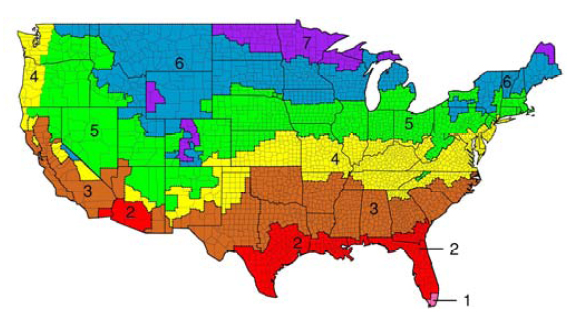I am one of the 'Pro's' on the Green Home Guide Website and as so I answer technical questions every month regarding green building. It is a very informative site!
Here is a link: http://greenhomeguide.com/
Below is one of my most recent question/answer's:
Q: New Construction, is a hybrid system the way to go for a 2x6 walls, 1 inch foam and the rest blown cellulose? Hybrid system vs just blown in cellulose for 2x6?
Asked by Scott
Paw Paw, MI

Hi Scott
As an Architect who designs only sustainable homes I am always a fan of the hybrid wall. But you have to do it right. You climate will heavily influence the type of hybrid wall you should build.
I see that Paw Paw, MI is in climate zone 5 but the northern edge of climate zone 5.
I live and work at the southern edge of climate zone 5 and a lot of our work falls to climate zone 4 or is right on the edge of 5 and 4.
Why am I saying all of this? Basically there is a ratio of exterior foam board insulation to interior cavity insulation that is ideal to achieve a great thermal envelope and at the same time avoid issues of moisture and mold occurring within the wall cavity. Basically the warmer the climate zone, the less exterior vs interior insulation you need to avoid air travelling into the wall cavity, reaching the dew point and turning into moisture.
So, in Zone 4 you can easily get away with 1 inch of polyiso rigid board insulation on the outside (about an R5) and 2x6 walls on the inside filled with foam or cellulose or some other cavity insulation. But when you get to Zone 5 you will get into trouble when you do that. In my area (southern Zone 5) you need at least an R7.5 (generally speaking) which is about an inch and a half. As you get more northern you need more- up to 2 or 2 ½ inches of rigid foam to your interior wall cavity.
The ironic thing is that – because this is all about the ratio of exterior to interior- if you build a 2x4 wall you need less exterior insulation. But in the colder climates what is the point of that? If you do that you significantly reduce the overall R value of your wall.
The biggest complication of putting more than 1” of rigid insulation on the exterior turns out to be construction. If you are only using 1” you can shoot your siding right through that to the stud beyond and it really does not complicate the construction process.
However if you are using more than an inch you have to introduce battens on top of the rigid insulation and lag through to the studs beyond and then attach your siding to the battens. (If you are using lap siding this is simple- battens are vertical to allow water to run down the wall, lap siding fastens horizontally across. But if you are using shingles or vertical panels you have to add horizontal nailers on top of the vertical battens and then attach shingles, panels etc. This is called a rain screen. There is more labor and a bit more material cost (battens are cheap).
This is a GREAT wall. Probably the best wall you can get. You get a lot of continuous insulation around the house plus you have an air space (the rainscreen) between you siding and the house itself. This air space makes the siding and the siding’s finish (no matter what kind of siding) last longer and require a lot less maintenance/ painting. If there is enough money in the job I will always go for this wall.
In your northern climate you deserve this wall! Your house will perform really well and you would not be sorry.
Another way to do the wall (my friends in Minnesota do this sort of wall primarily) is to simply build a double wall. Maybe a 2x4 wall, then a 2 “ gap, then another 2x4 wall. Fill the whole thing with whatever insulation you like. Cuts thermal bridging and you avoid the ratio issue.
One big factor of getting your wall to perform well is to focus on air infiltration as well as R Values. Some insulations like spray foams and rigid foam boards have their own innate air barrier properties, whereas batt and loose fill insulations like cellulose, cotton batt, blown fiberglass, etc do not. If you use one of the latter you should also pay very close attention so sealing all air gaps in the wall assembly. (You should do so with the foams as well, of course. There are simple less gaps in the foamed walls. ) That is a whole other topic.
In summing up- hybrid walls are great, you just have to do them right. There is a lot of information and complexity to true building science. You can usually get more help form one of your local green building professional to talk through your exact project. Just make sure whomever you talk to really knows their stuff and didn’t just recently become ‘green’ for marketing reasons!
Best of luck!
Elizabeth DiSalvo, Architect
